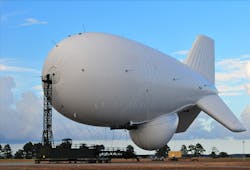Missile defense systems must identify and respond to incoming threats in a short amount of time. Although they have reached great heights, US missile-defense efforts have thus far been contained to land. Recently, however, a US Army and Navy test demonstrated that Raytheon Co.’s Joint Land Attack/Cruise Missile Defense Elevated Netted Sensors (JLENS) can integrate with the defensive systems currently in the Navy’s inventory. In doing so, they can provide overland cruise-missile defense from the sea.
During this test, a JLENS fire-control radar acquired and tracked a surrogate anti-ship cruise-missile target. That information was passed to sailors via the Raytheon-made Cooperative Engagement Capability (CEC) sensor-netting system. [CEC nets battleforce sensors together to provide a single, distributed Anti-Air Warfare (AAW) defense capability.] The sailors then fired a Raytheon-made Standard Missile-6 at the target. Initial SM-6 guidance used targeting information provided by the JLENS via CEC to the Aegis Weapon System (AWS) until the SM-6’s on-board radar was able to acquire and track the target.
JLENS is an elevated, persistent, over-the-horizon sensor system. It uses an integrated radar system to detect, track, and target a variety of threats. A JLENS system, which is referred to as an orbit, consists of two tethered, 74-m, helium-filled aerostats connected to both mobile mooring stations and communications and processing groups (see photo). The aerostats fly as high as 10,000 feet and can remain aloft and operational for up to 30 days. One aerostat carries a surveillance radar with 360-deg. surveillance capability while the other carries a fire-control radar.
